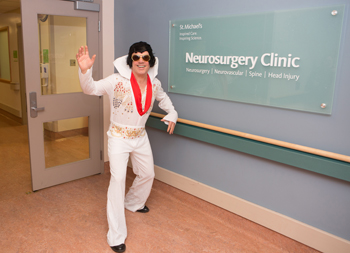ELVIS is in the building

By Geoff Koehler

Which doctor is all shook up as he celebrates the launch of Code ELVIS — a code to streamline treatment for patients during a specific kind of stroke. To find out, keep reading. (Photo by Yuri Markarov)
An ischemic stroke occurs when a blood vessel is blocked and the brain’s blood supply is cut off. Every minute that blood can’t reach the brain, 1.9 million neurons are lost. Without timely treatment, this brain clot can cause severe disability and even death.
For nearly 20 years, a clot-busting drug called tissue-type plasminogen activator, or tPA, has been the only therapy with proven clinical benefit for patients experiencing an ischemic stroke. When the blockage is in a large blood vessel, however, research has shown that rapidly removing the clot can lead to better outcomes than tPA alone.
“To implement these findings, stroke at St. Michael’s was all shook up so that we coined a new code, ELVIS, to get the patients who would benefit from this intervention into the neuroangiography suite faster,” said Dr. Tom Marotta, an interventional neuroradiologist with the Medical Imaging Department. “Now there’s a little less conversation that needs to happen before patients can get their clot removed.”
Code ELVIS, which stands for Endovascular Large Vessel Ischemic Stroke, was launched Dec. 18 to reduce process times and improve patient outcomes. Under Code ELVIS, patients with a large vessel ischemic stroke who are coming to St. Michael’s in an ambulance are registered as patients even before arriving at the Emergency Department.
Did you know? Code ELVIS was developed in consultation with patients and families, the Neurointerventional group, the Emergency Department, Stroke Neurology, Medical Imaging, the hospital’s Critical Care Response Team, Toronto Paramedic Services and CritiCall. |
When paramedics arrive at the hospital with a stroke patient, the patient will stay on the ambulance stretcher through the ED, up to the CT scanner for assessment, and then to the neuroangigraphy suite if the blockage meets the criteria.
“Code ELVIS is similar to the hospital’s Code STEMI – which is for someone having a blocked heart blood vessel best treated by angioplasty – but this is for a blocked blood vessel in the brain causing a stroke,” said Dr. Daniel Selchen, director of St. Michael’s Regional Stroke Centre. With the addition of Code ELVIS, each patient group will receive the best urgent and possibly life-saving stroke treatments for which St. Michael’s is known.”
About St. Michael’s Hospital
St. Michael’s Hospital provides compassionate care to all who enter its doors. The hospital also provides outstanding medical education to future health care professionals in more than 29 academic disciplines. Critical care and trauma, heart disease, neurosurgery, diabetes, cancer care, care of the homeless and global health are among the Hospital’s recognized areas of expertise. Through the Keenan Research Centre and the Li Ka Shing International Healthcare Education Centre, which make up the Li Ka Shing Knowledge Institute, research and education at St. Michael’s Hospital are recognized and make an impact around the world. Founded in 1892, the hospital is fully affiliated with the University of Toronto.
